Quantum Graphene Asymmetric Devices for Harvesting Electromagnetic Energy
Abstract
1. Introduction
2. Fabrication of Quantum Graphene Diodes at the Wafer Scale
3. Measurements and Discussion
4. Conclusions
Author Contributions
Funding
Data Availability Statement
Conflicts of Interest
References
- Dragoman, D.; Dragoman, M. Geometrically Induced Rectification in Two-Dimensional Ballistic Nanodevices. J. Phys. D Appl. Phys. 2013, 46, 055306. [Google Scholar] [CrossRef]
- Dragoman, M.; Dinescu, A.; Dragoman, D. On-Wafer Graphene Diodes for High-Frequency Applications. In Proceedings of the IEEE 2013 European Solid-State Device Research Conference (ESSDERC), Bucharest, Romania, 16–20 September 2013; IEEE: Piscataway, NJ, USA, 2013; pp. 322–325. [Google Scholar]
- Moddel, G.; Zhu, Z.; Grover, S.; Joshi, S. Ultrahigh Speed Graphene Diode with Reversible Polarity. Solid. State Commun. 2012, 152, 1842–1845. [Google Scholar] [CrossRef]
- Efil, E.; Kaymak, N.; Seven, E.; Orhan, E.O.; Bayram, O.; Ocak, S.B.; Tataroglu, A. Current–Voltage Analyses of Graphene-Based Structure onto Al2O3/p-Si Using Various Methods. Vacuum 2020, 181, 109654. [Google Scholar] [CrossRef]
- Orhan, E.O.; Efil, E.; Bayram, O.; Kaymak, N.; Berberoğlu, H.; Candemir, O.; Pavlov, I.; Ocak, S.B. 3D-Graphene-Laser Patterned p-Type Silicon Schottky Diode. Mater. Sci. Semicond. Process 2021, 121, 105454. [Google Scholar] [CrossRef]
- Nguyen, H.; Yen, Z.; Su, Y.; Hsieh, Y.; Hofmann, M. 2D Material-Enabled Optical Rectennas with Ultrastrong Light-Electron Coupling. Small 2022, 18, 2202199. [Google Scholar] [CrossRef]
- Wang, H.; Chen, M.; Yang, Y.; Ma, Y.; Luo, L.; Liu, C.; Getmanov, I.; Anthopoulos, T.D.; Zhang, X.; Shamim, A. A Graphene Geometric Diode with the Highest Asymmetry Ratio and Three States Gate-Tunable Rectification Ability. Adv. Electron. Mater. 2024, 10, 2300695. [Google Scholar] [CrossRef]
- Dragoman, M.; Dragoman, D.; Deligiorgis, G.; Konstantinidis, G.; Neculoiu, D.; Cismaru, A.; Plana, R. Current Oscillations in a Wide Graphene Sheet. J. Appl. Phys. 2009, 106, 044312. [Google Scholar] [CrossRef]
- Pizzocchero, F.; Gammelgaard, L.; Jessen, B.S.; Caridad, J.M.; Wang, L.; Hone, J.; Bøggild, P.; Booth, T.J. The Hot Pick-up Technique for Batch Assembly of van Der Waals Heterostructures. Nat. Commun. 2016, 7, 11894. [Google Scholar] [CrossRef]
- Mayorov, A.S.; Gorbachev, R.V.; Morozov, S.V.; Britnell, L.; Jalil, R.; Ponomarenko, L.A.; Blake, P.; Novoselov, K.S.; Watanabe, K.; Taniguchi, T.; et al. Micrometer-Scale Ballistic Transport in Encapsulated Graphene at Room Temperature. Nano Lett. 2011, 11, 2396–2399. [Google Scholar] [CrossRef]
- Gholivand, H.; Donmezer, N. Phonon Mean Free Path in Few Layer Graphene, Hexagonal Boron Nitride, and Composite Bilayer h-BN/Graphene. IEEE Trans. Nanotechnol. 2017, 16, 752–758. [Google Scholar] [CrossRef]
- Ridley, M.; Sentef, M.; Tuovinen, R. Electron Traversal Times in Disordered Graphene Nanoribbons. Entropy 2019, 21, 737. [Google Scholar] [CrossRef] [PubMed]
- Mohebbi, E.; Pavoni, E.; Pierantoni, L.; Stipa, P.; Hemmetter, A.; Laudadio, E.; Mencarelli, D. Towards Graphene-Based Asymmetric Diodes: A Density Functional Tight-Binding Study. Nanoscale Adv. 2024, 6, 1548–1555. [Google Scholar] [CrossRef] [PubMed]
- Andelkovic, M.; Rakhimov, K.Y.; Chaves, A.; Berdiyorov, G.R.; Milošević, M.V. Wave-Packet Propagation in a Graphene Geometric Diode. Phys. E Low. Dimens. Syst. Nanostruct. 2023, 147, 115607. [Google Scholar] [CrossRef]
- Mencarelli, D.; Zampa, G.M.; Pierantoni, L. Current-Voltage Characterization of Multi-Port Graphene Based Geometric Diodes for High-Frequency Electromagnetic Harvesting. IEEE Access 2022, 10, 123251–123258. [Google Scholar] [CrossRef]
- Auton, G.; But, D.B.; Zhang, J.; Hill, E.; Coquillat, D.; Consejo, C.; Nouvel, P.; Knap, W.; Varani, L.; Teppe, F.; et al. Terahertz Detection and Imaging Using Graphene Ballistic Rectifiers. Nano Lett. 2017, 17, 7015–7020. [Google Scholar] [CrossRef] [PubMed]
- Ludwig, F.; Generalov, A.; Holstein, J.; Murros, A.; Viisanen, K.; Prunnila, M.; Roskos, H.G. Terahertz Detection with Graphene FETs: Photothermoelectric and Resistive Self-Mixing Contributions to the Detector Response. ACS Appl. Electron. Mater. 2024, 6, 2197–2212. [Google Scholar] [CrossRef]
- Dragoman, M.; Aldrigo, M.; Dinescu, A.; Dragoman, D.; Costanzo, A. Towards a Terahertz Direct Receiver Based on Graphene up to 10 THz. J. Appl. Phys. 2014, 115, 044307. [Google Scholar] [CrossRef]
- Asgari, M.; Riccardi, E.; Balci, O.; De Fazio, D.; Shinde, S.M.; Zhang, J.; Mignuzzi, S.; Koppens, F.H.L.; Ferrari, A.C.; Viti, L.; et al. Chip-Scalable, Room-Temperature, Zero-Bias, Graphene-Based Terahertz Detectors with Nanosecond Response Time. ACS Nano 2021, 15, 17966–17976. [Google Scholar] [CrossRef]
- Masotti, D.; Costanzo, A.; Fantuzzi, M.; Mastri, F.; Aldrigo, M.; Dragoman, M. Graphene-Based Nano-Rectenna in the Far Infrared Frequency Band. In Proceedings of the IEEE 2014 44th European Microwave Conference, Rome, Italy, 6–9 October 2014; IEEE: Piscataway, NJ, USA, 2014; pp. 1202–1205. [Google Scholar]
- Li, Z.; Cai, W.; Song, L.; Gui, Z.; Hu, Y.; Wang, X. A Novel Strategy to Extend Near-Infrared Light Harvest of Graphene for Solar Vapor Generation and High-Efficiency Oil-Water Separation. Appl. Surf. Sci. 2023, 609, 155286. [Google Scholar] [CrossRef]
- Zhu, Z.; Joshi, S.; Moddel, G. High Performance Room Temperature Rectenna IR Detectors Using Graphene Geometric Diodes. IEEE J. Sel. Top. Quantum Electron. 2014, 20, 70–78. [Google Scholar] [CrossRef]
- Dragoman, M.; Dinescu, A.; Vulpe, S.; Dragoman, D. Subthreshold Slope below 60 MV/Decade in Graphene Transistors Induced by Channel Geometry at the Wafer-Scale. Nanotechnology 2024, 35, 135201. [Google Scholar] [CrossRef] [PubMed]
- Shin, D.-H.; You, Y.G.; Jo, S., II; Jeong, G.-H.; Campbell, E.E.B.; Chung, H.-J.; Jhang, S.H. Low-Power Complementary Inverter Based on Graphene/Carbon-Nanotube and Graphene/MoS2 Barristors. Nanomaterials 2022, 12, 3820. [Google Scholar] [CrossRef] [PubMed]
- Nazir, G.; Rehman, A.; Park, S.-J. Energy-Efficient Tunneling Field-Effect Transistors for Low-Power Device Applications: Challenges and Opportunities. ACS Appl. Mater. Interfaces 2020, 12, 47127–47163. [Google Scholar] [CrossRef]
- Sotoudeh, A.; Amirmazlaghani, M. Graphene-Based Field Effect Diode. Superlattices Microstruct. 2018, 120, 828–836. [Google Scholar] [CrossRef]
- Vijh, M.; Gupta, R.S.; Pandey, S. Graphene Based Tunnel Field Effect Transistor for RF Applications. In Proceedings of the IEEE 2019 PhotonIcs & Electromagnetics Research Symposium—Spring (PIERS-Spring), Rome, Italy 17–20 June 2019; IEEE: Piscataway, NJ, USA, 2019; pp. 256–259. [Google Scholar]
- Cai, Q.; Ye, J.; Jahannia, B.; Wang, H.; Patil, C.; Al Foysal Redoy, R.; Sidam, A.; Sameer, S.; Aljohani, S.; Umer, M.; et al. Comprehensive Study and Design of Graphene Transistor. Micromachines 2024, 15, 406. [Google Scholar] [CrossRef]
- Wang, Z.; Hemmetter, A.; Uzlu, B.; Saeed, M.; Hamed, A.; Kataria, S.; Negra, R.; Neumaier, D.; Lemme, M.C. Graphene in 2D/3D Heterostructure Diodes for High Performance Electronics and Optoelectronics. Adv. Electron. Mater. 2021, 7, 2001210. [Google Scholar] [CrossRef]
- Nguyen, V.H.; Nguyen, D.C.; Kumar, S.; Kim, M.; Kang, D.; Lee, Y.; Nasir, N.; Rehman, M.A.; Bach, T.P.A.; Jung, J.; et al. Optimum Design for the Ballistic Diode Based on Graphene Field-Effect Transistors. NPJ 2D Mater. Appl. 2021, 5, 89. [Google Scholar] [CrossRef]
- Semkin, V.A.; Shabanov, A.V.; Mylnikov, D.A.; Kashchenko, M.A.; Domaratskiy, I.K.; Zhukov, S.S.; Svintsov, D.A. Zero-Bias Photodetection in 2D Materials via Geometric Design of Contacts. Nano Lett. 2023, 23, 5250–5256. [Google Scholar] [CrossRef]
- Seo, J.; Kim, Y.J.; Yoo, H. Zero Bias Operation: Photodetection Behaviors Obtained by Emerging Materials and Device Structures. Micromachines 2022, 13, 2089. [Google Scholar] [CrossRef]
- Wei, J.; Li, Y.; Wang, L.; Liao, W.; Dong, B.; Xu, C.; Zhu, C.; Ang, K.-W.; Qiu, C.-W.; Lee, C. Zero-Bias Mid-Infrared Graphene Photodetectors with Bulk Photoresponse and Calibration-Free Polarization Detection. Nat. Commun. 2020, 11, 6404. [Google Scholar] [CrossRef]
- Chen, M.; Ma, J.; Li, P.; Xu, H.; Liu, Y. Zero-Biased Deep Ultraviolet Photodetectors Based on Graphene/Cleaved (100) Ga2O3 Heterojunction. Opt. Express 2019, 27, 8717. [Google Scholar] [CrossRef] [PubMed]
- Xie, J.; Ren, Z.; Wei, J.; Liu, W.; Zhou, J.; Lee, C. Zero-Bias Long-Wave Infrared Nanoantenna-Mediated Graphene Photodetector for Polarimetric and Spectroscopic Sensing. Adv. Opt. Mater. 2023, 11, 2202867. [Google Scholar] [CrossRef]
- Moon, J.S.; Seo, H.-C.; Antcliffe, M.; Lin, S.; McGuire, C.; Le, D.; Nyakiti, L.O.; Gaskill, D.K.; Campbell, P.M.; Lee, K.-M.; et al. Graphene FET-Based Zero-Bias RF to Millimeter-Wave Detection. IEEE Electron. Device Lett. 2012, 33, 1357–1359. [Google Scholar] [CrossRef]
- Mišeikis, V.; Marconi, S.; Giambra, M.A.; Montanaro, A.; Martini, L.; Fabbri, F.; Pezzini, S.; Piccinini, G.; Forti, S.; Terrés, B.; et al. Ultrafast, Zero-Bias, Graphene Photodetectors with Polymeric Gate Dielectric on Passive Photonic Waveguides. ACS Nano 2020, 14, 11190–11204. [Google Scholar] [CrossRef] [PubMed]
- Gao, K.; Ran, S.; Han, Q.; Yang, Q.; Jiang, H.; Fu, J.; Leng, C.; Feng, S.; Zhou, D.; Li, Z.; et al. High Zero-Bias Responsivity Induced by Photogating Effect in Asymmetric Device Structure. Opt Mater. 2022, 124, 112013. [Google Scholar] [CrossRef]
- Yang, J.H.; Shin, J.H.; Kim, S.; Pyo, G.; Jang, A.-R.; Yang, H.W.; Kang, D.J.; Jang, J.E. Geometrically Enhanced Graphene Tunneling Diode with Lateral Nano-Scale Gap. IEEE Electron. Device Lett. 2019, 40, 1840–1843. [Google Scholar] [CrossRef]
- Chen, B.; Fan, L.; Bi, J.; Li, Z.; Xu, Z.; Majumdar, S. Nanoscale Air Channel Devices- Inheritance and Breakthrough of Vacuum Tube. Nano Mater. Sci. 2024. [Google Scholar] [CrossRef]
- Li, N.; Zhang, B.; He, Y.; Luo, Y. Sub-Picosecond Nanodiodes for Low-Power Ultrafast Electronics. Adv. Mater. 2021, 33, 2100874. [Google Scholar] [CrossRef] [PubMed]
- Byrnes, S.J.; Blanchard, R.; Capasso, F. Harvesting Renewable Energy from Earth’s Mid-Infrared Emissions. Proc. Natl. Acad. Sci. USA 2014, 111, 3927–3932. [Google Scholar] [CrossRef]
- Britnell, L.; Gorbachev, R.V.; Jalil, R.; Belle, B.D.; Schedin, F.; Katsnelson, M.I.; Eaves, L.; Morozov, S.V.; Mayorov, A.S.; Peres, N.M.R.; et al. Electron Tunneling through Ultrathin Boron Nitride Crystalline Barriers. Nano Lett. 2012, 12, 1707–1710. [Google Scholar] [CrossRef]
- Britnell, L.; Gorbachev, R.V.; Geim, A.K.; Ponomarenko, L.A.; Mishchenko, A.; Greenaway, M.T.; Fromhold, T.M.; Novoselov, K.S.; Eaves, L. Resonant Tunnelling and Negative Differential Conductance in Graphene Transistors. Nat. Commun. 2013, 4, 1794. [Google Scholar] [CrossRef] [PubMed]
- Zhang, Z.; Zhang, B.; Wang, Y.; Wang, M.; Zhang, Y.; Li, H.; Zhang, J.; Song, A. Toward High-Peak-to-Valley-Ratio Graphene Resonant Tunneling Diodes. Nano Lett. 2023, 23, 8132–8139. [Google Scholar] [CrossRef] [PubMed]
- Nguyen, L.-N.; Lan, Y.-W.; Chen, J.-H.; Chang, T.-R.; Zhong, Y.-L.; Jeng, H.-T.; Li, L.-J.; Chen, C.-D. Resonant Tunneling through Discrete Quantum States in Stacked Atomic-Layered MoS2. Nano Lett. 2014, 14, 2381–2386. [Google Scholar] [CrossRef] [PubMed]
- Xiong, X.; Huang, M.; Hu, B.; Li, X.; Liu, F.; Li, S.; Tian, M.; Li, T.; Song, J.; Wu, Y. A Transverse Tunnelling Field-Effect Transistor Made from a van Der Waals Heterostructure. Nat. Electron. 2020, 3, 106–112. [Google Scholar] [CrossRef]
- Kumar, A.; Viscardi, L.; Faella, E.; Giubileo, F.; Intonti, K.; Pelella, A.; Sleziona, S.; Kharsah, O.; Schleberger, M.; Di Bartolomeo, A. Black Phosphorus Unipolar Transistor, Memory, and Photodetector. J. Mater. Sci. 2023, 58, 2689–2699. [Google Scholar] [CrossRef]
- Dragoman, M.; Dragoman, D. Negative Differential Resistance in Novel Nanoscale Devices. Solid. State Electron. 2022, 197, 108464. [Google Scholar] [CrossRef]
- Caridad, J.M.; Power, S.R.; Lotz, M.R.; Shylau, A.A.; Thomsen, J.D.; Gammelgaard, L.; Booth, T.J.; Jauho, A.-P.; Bøggild, P. Conductance Quantization Suppression in the Quantum Hall Regime. Nat. Commun. 2018, 9, 659. [Google Scholar] [CrossRef]
- Ferry, D.K.; Goodnick, S.M.; Bird, J. Transport in Nanostructures; Cambridge University Press: Cambridge, UK, 2009; ISBN 9780521877480. [Google Scholar]
- Dragoman, M.; Aldrigo, M.; Dinescu, A.; Vasilache, D.; Iordanescu, S.; Dragoman, D. Nanomaterials and Devices for Harvesting Ambient Electromagnetic Waves. Nanomaterials 2023, 13, 595. [Google Scholar] [CrossRef]
- Gehring, P.; Sadeghi, H.; Sangtarash, S.; Lau, C.S.; Liu, J.; Ardavan, A.; Warner, J.H.; Lambert, C.J.; Briggs, G.; Andrew, D.; et al. Quantum Interference in Graphene Nanoconstrictions. Nano Lett. 2016, 16, 4210–4216. [Google Scholar] [CrossRef]
- Westlund, A.; Winters, M.; Ivanov, I.G.; Hassan, J.; Nilsson, P.-Å.; Janzén, E.; Rorsman, N.; Grahn, J. Graphene Self-Switching Diodes as Zero-Bias Microwave Detectors. Appl. Phys. Lett. 2015, 106, 093116. [Google Scholar] [CrossRef]



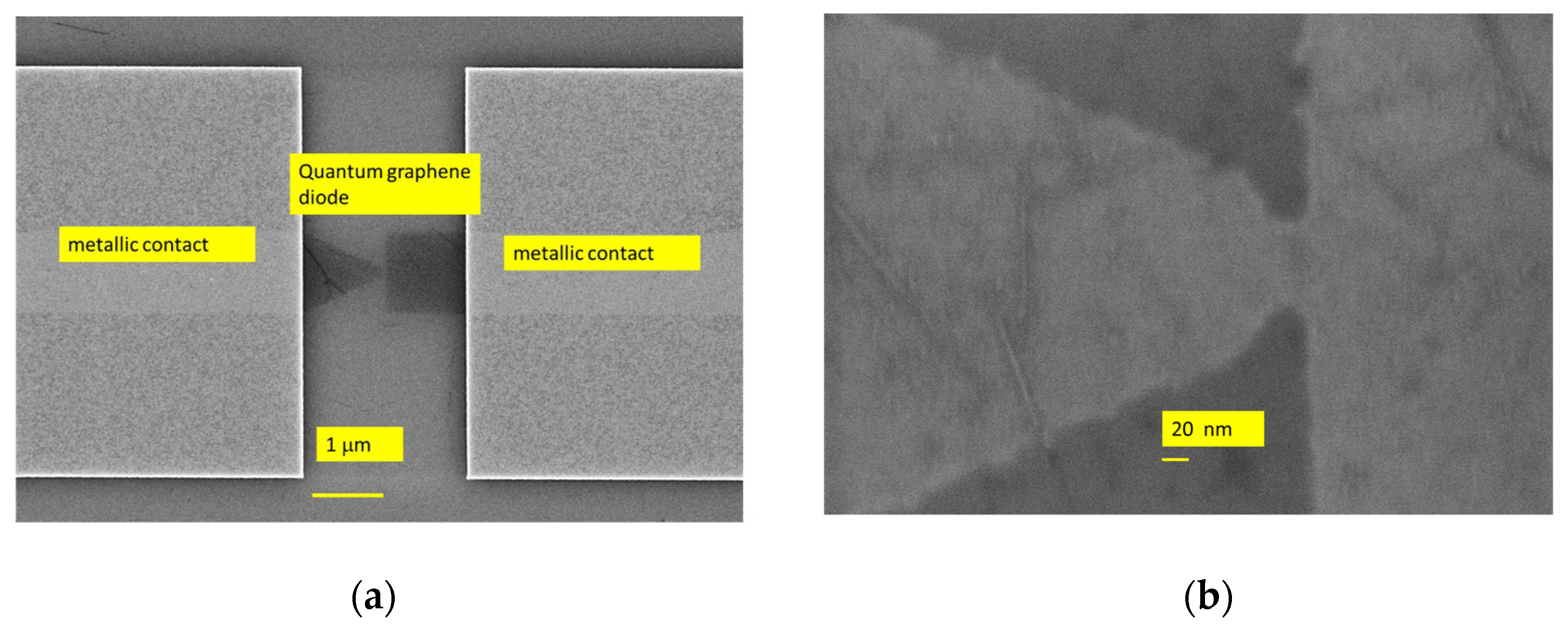
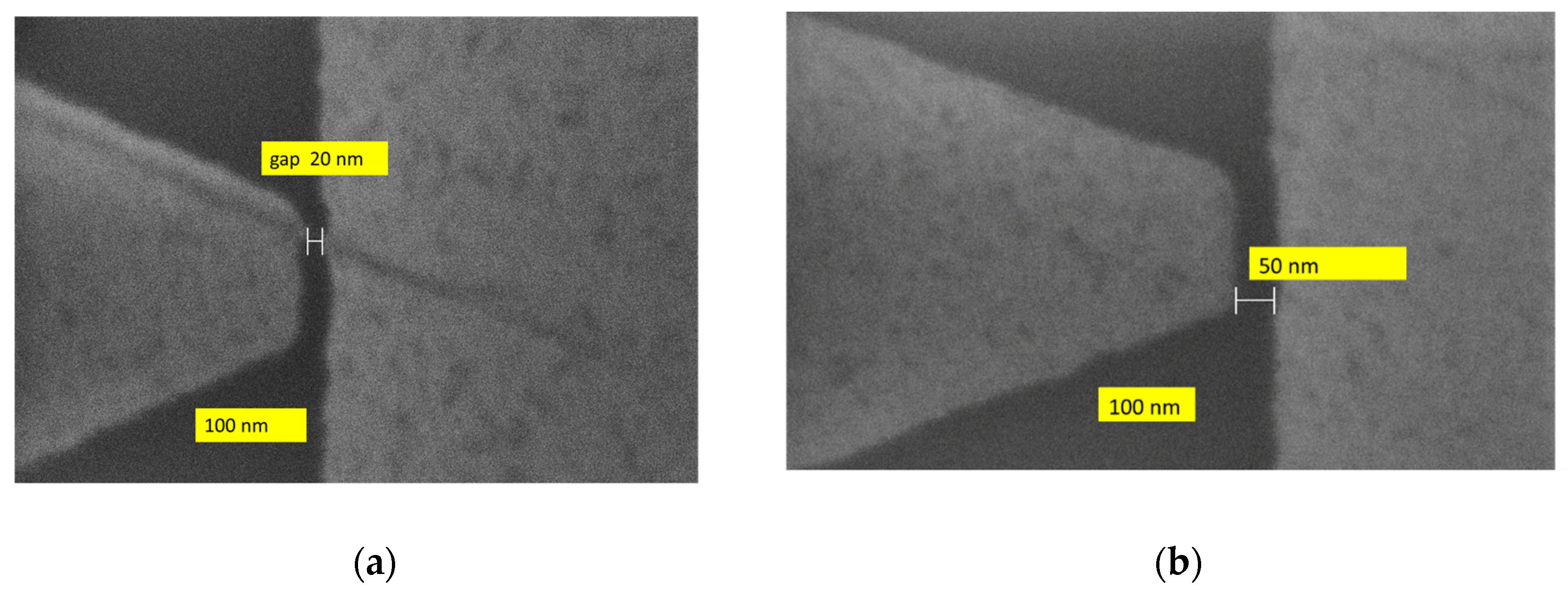
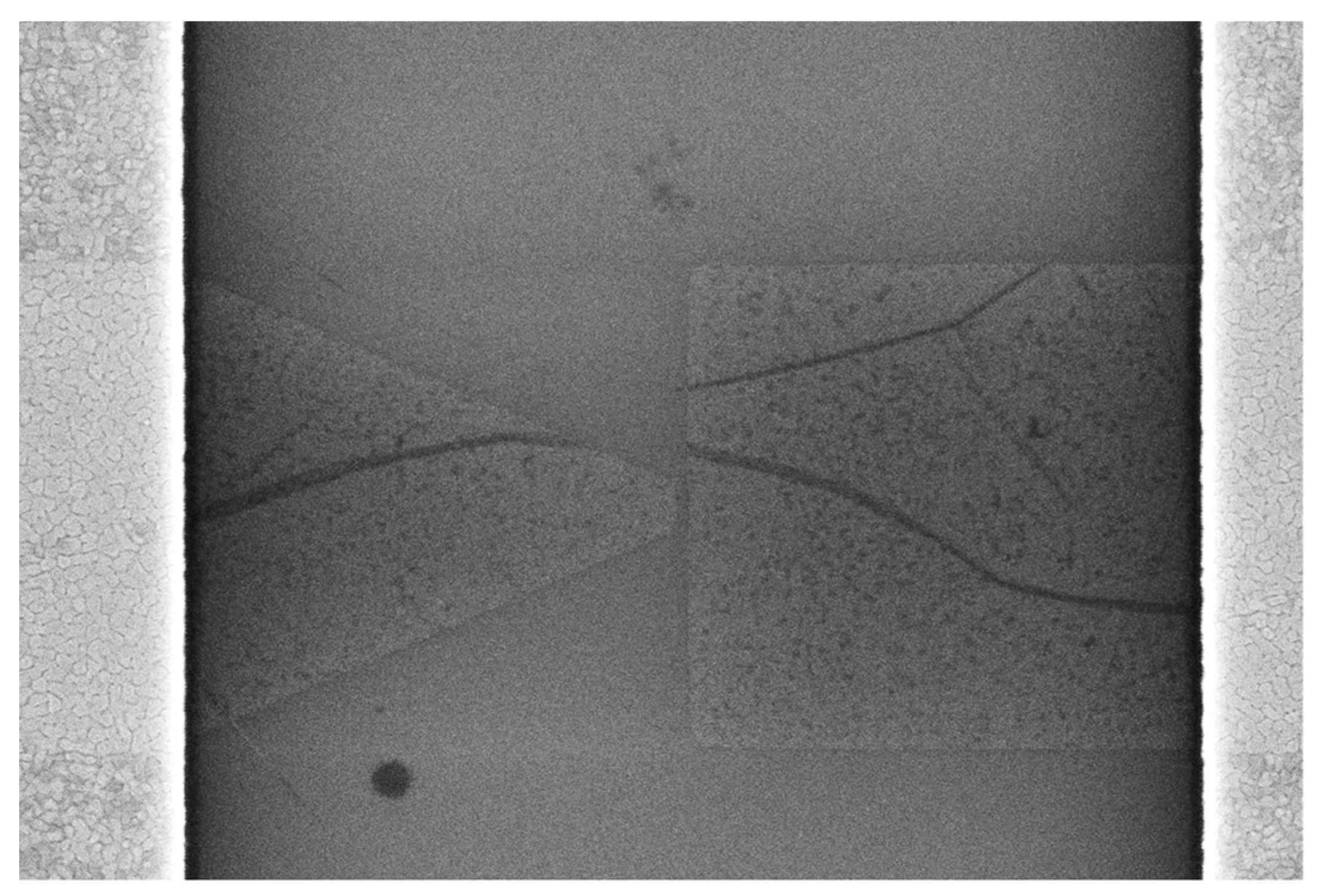
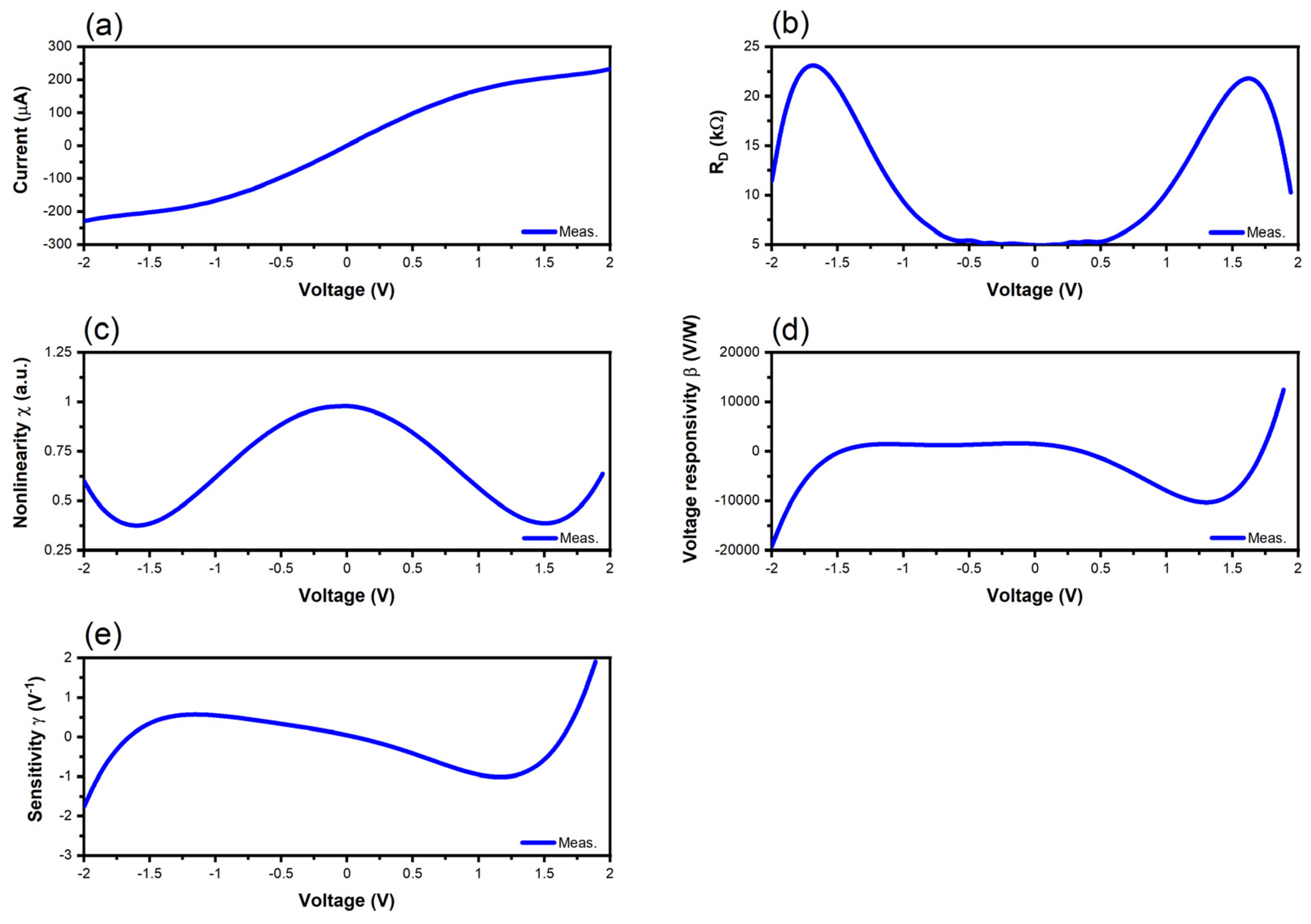
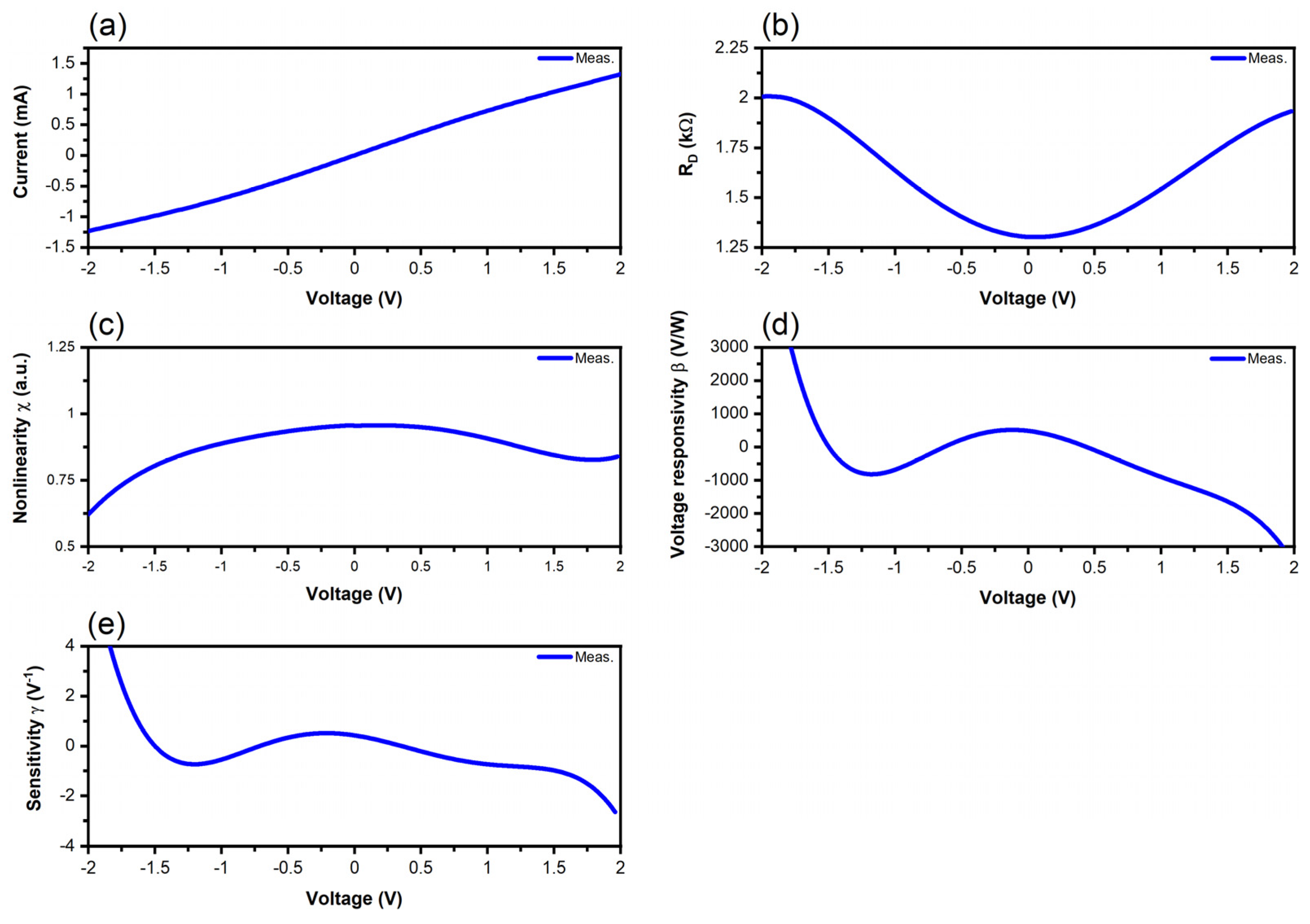
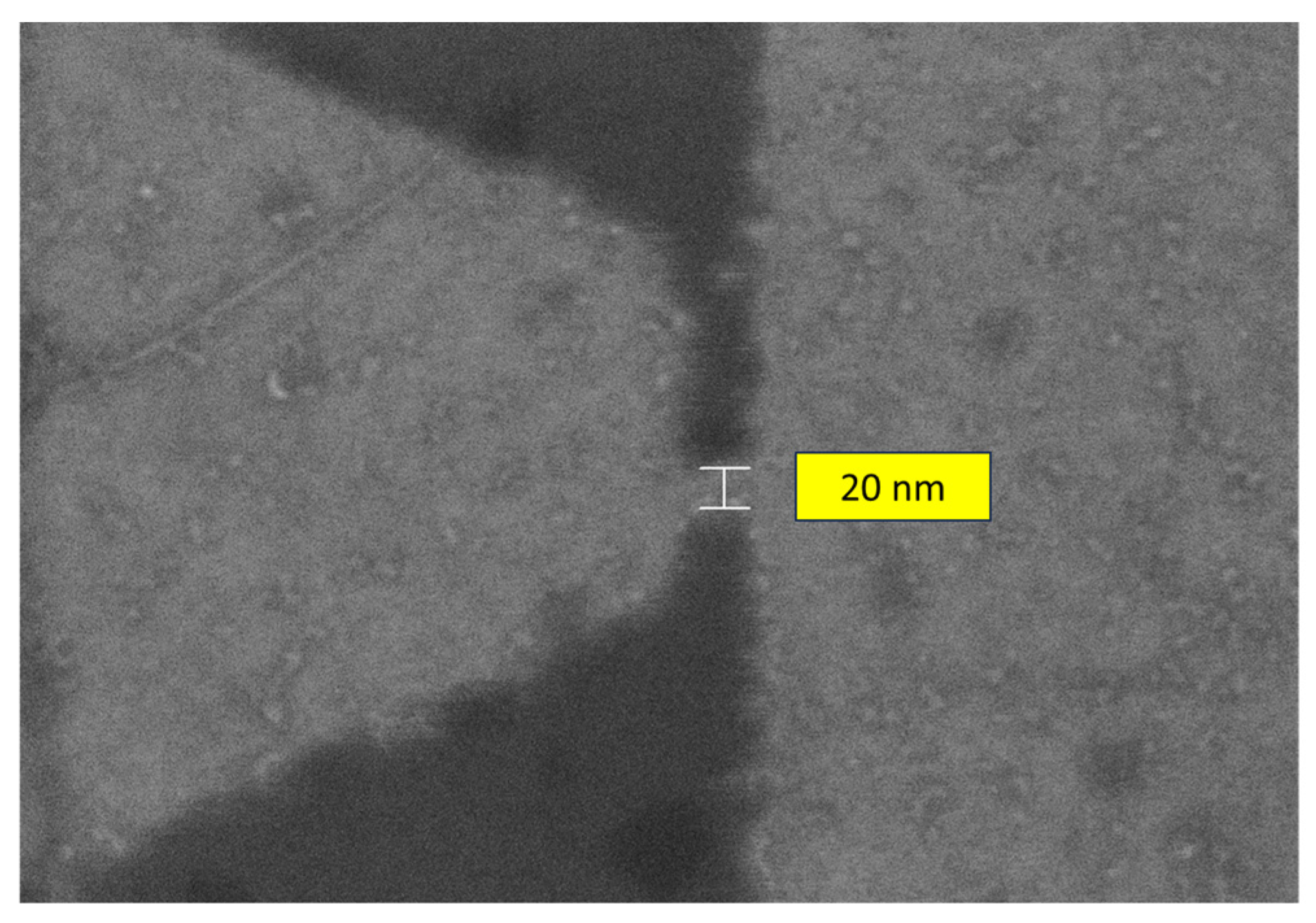
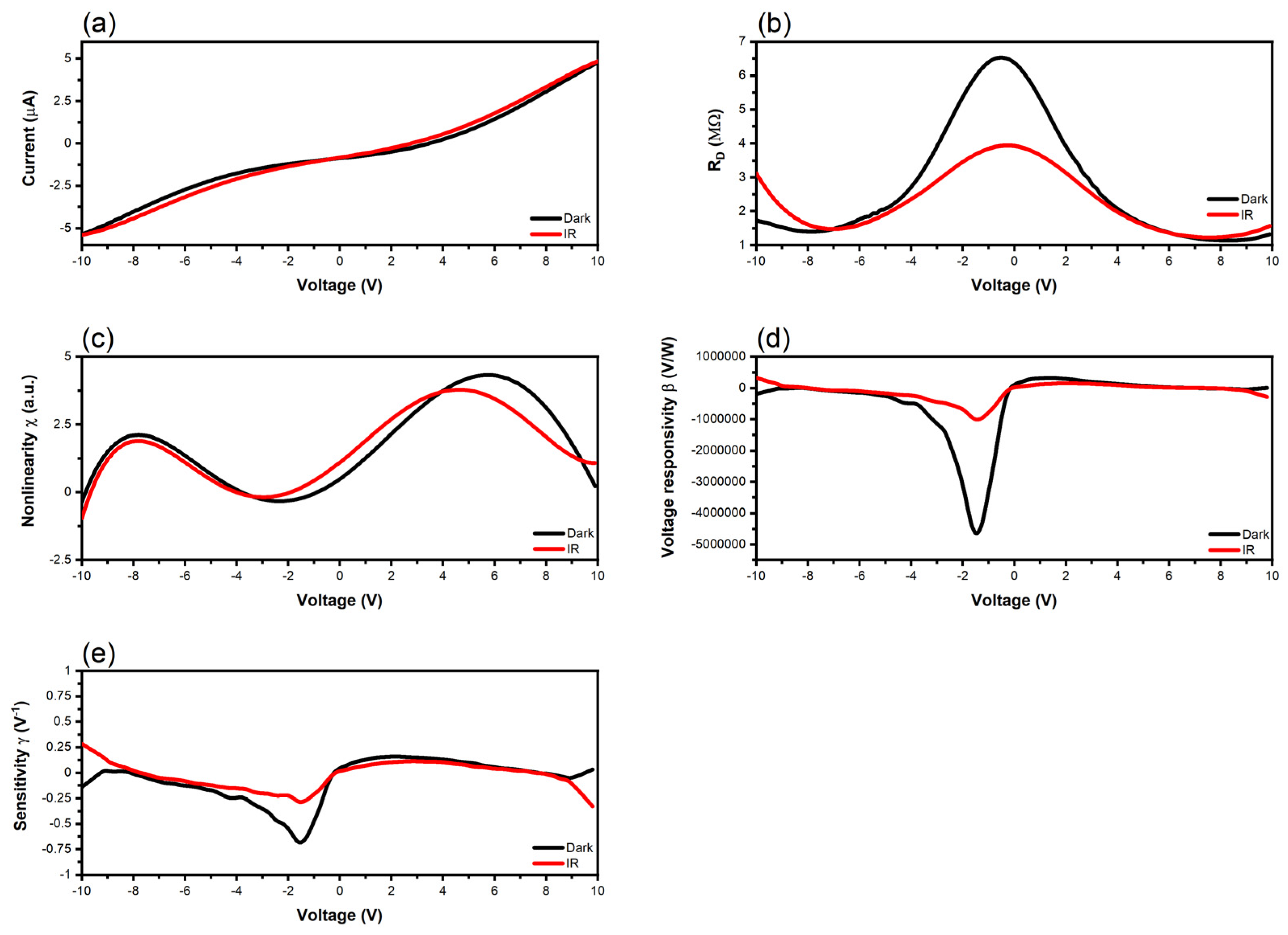
Disclaimer/Publisher’s Note: The statements, opinions and data contained in all publications are solely those of the individual author(s) and contributor(s) and not of MDPI and/or the editor(s). MDPI and/or the editor(s) disclaim responsibility for any injury to people or property resulting from any ideas, methods, instructions or products referred to in the content. |
© 2024 by the authors. Licensee MDPI, Basel, Switzerland. This article is an open access article distributed under the terms and conditions of the Creative Commons Attribution (CC BY) license (https://creativecommons.org/licenses/by/4.0/).
Share and Cite
Dragoman, M.; Dinescu, A.; Aldrigo, M.; Dragoman, D. Quantum Graphene Asymmetric Devices for Harvesting Electromagnetic Energy. Nanomaterials 2024, 14, 1114. https://doi.org/10.3390/nano14131114
Dragoman M, Dinescu A, Aldrigo M, Dragoman D. Quantum Graphene Asymmetric Devices for Harvesting Electromagnetic Energy. Nanomaterials. 2024; 14(13):1114. https://doi.org/10.3390/nano14131114
Chicago/Turabian StyleDragoman, Mircea, Adrian Dinescu, Martino Aldrigo, and Daniela Dragoman. 2024. "Quantum Graphene Asymmetric Devices for Harvesting Electromagnetic Energy" Nanomaterials 14, no. 13: 1114. https://doi.org/10.3390/nano14131114
APA StyleDragoman, M., Dinescu, A., Aldrigo, M., & Dragoman, D. (2024). Quantum Graphene Asymmetric Devices for Harvesting Electromagnetic Energy. Nanomaterials, 14(13), 1114. https://doi.org/10.3390/nano14131114







